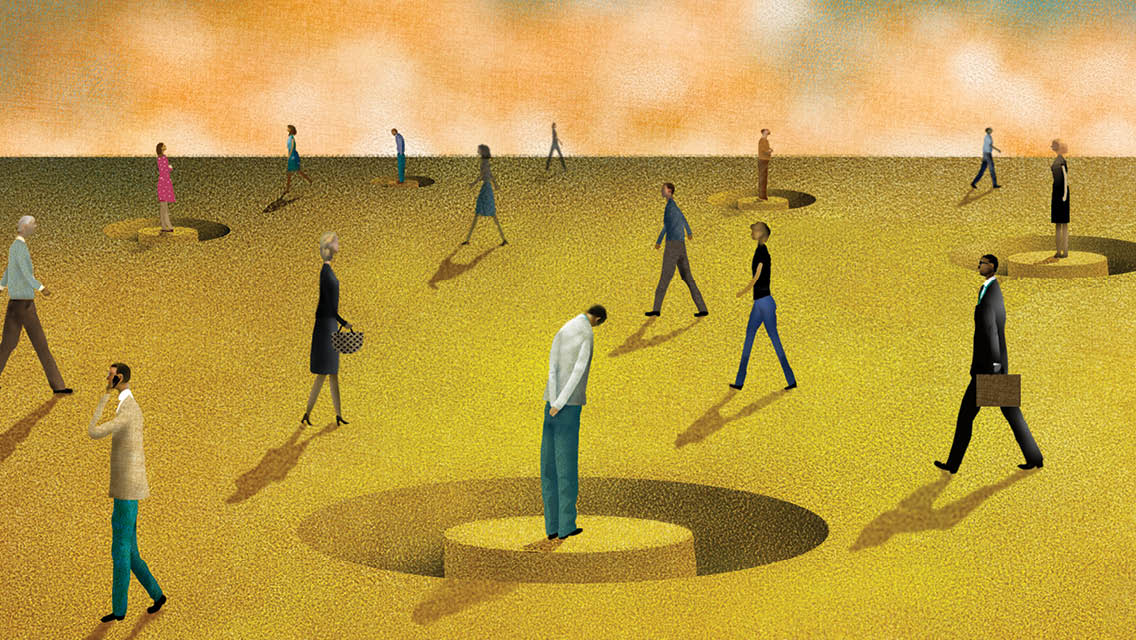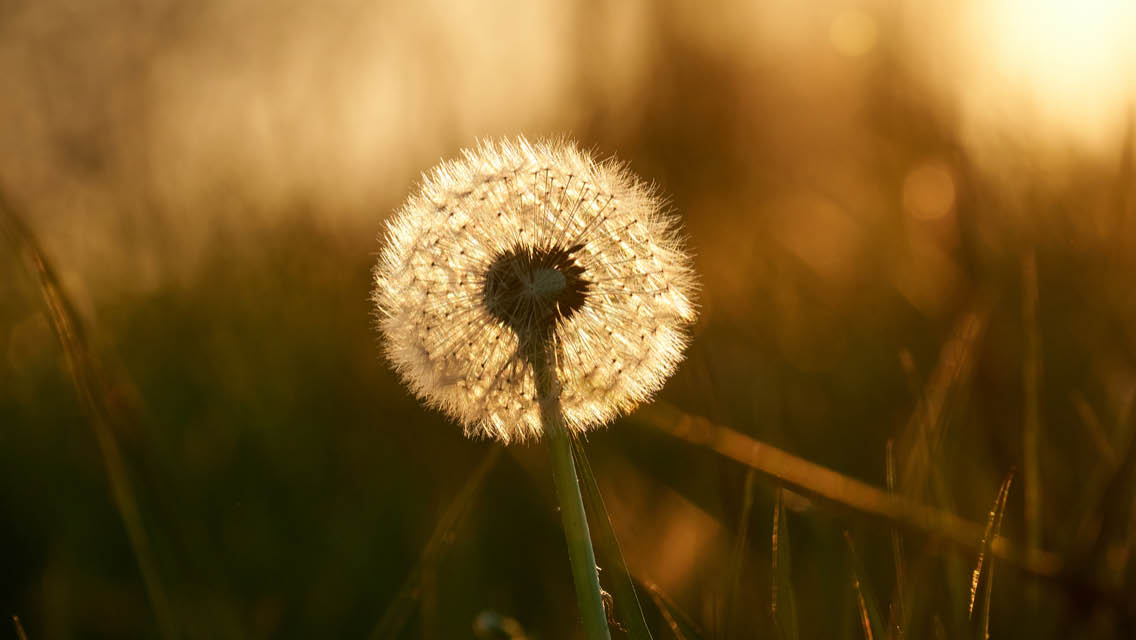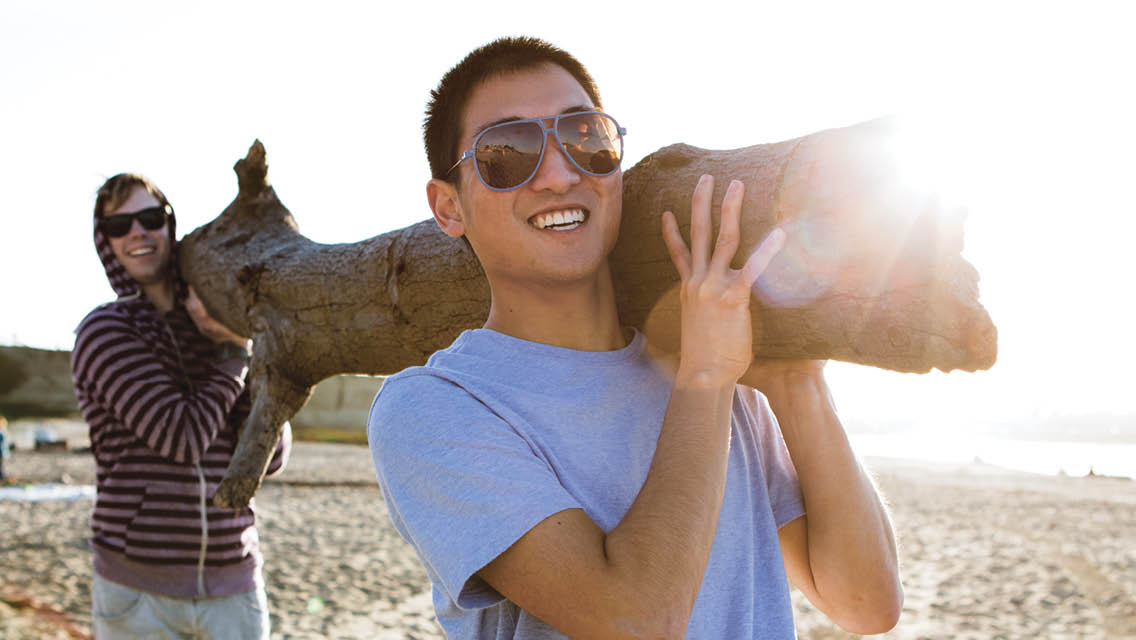Alfred, 94, lives alone in the house where he and his late wife raised their family. Hard of hearing and nearly blind, he waits every day in an easy chair by the front door for his daily visit from a Meals on Wheels volunteer. Every other Thursday, I’m that volunteer. I always linger for as long as I can, chatting with him, and he soaks up the conversation like a thirsty sponge. It’s the only interaction he has most days.
Lately, Alfred has been complaining of poor sleep. Pills don’t help. He tosses and turns and wakes up still feeling tired. As it turns out, fractured sleep is one of the main symptoms of chronic loneliness. Alfred appears to be one of millions of Americans suffering from it, as well as social isolation.
Even before the pandemic, more than 20 percent of Americans who were 65 years old or older and living in community settings reported feeling socially isolated, a condition featuring few social relationships and infrequent social contact. Still, social isolation and loneliness are different: Loneliness is the feeling of being isolated, and we can experience it even when we’re surrounded by people. (For more on the difference between loneliness and isolation, see “The Health Effects of Loneliness and Isolation“.)
In 1985, American adults had an average of three close confidants. By 2004, the average was two, and roughly one in four Americans reported having no close confidants at all. This suggests that for many of us, even if we have plenty of people around, our social connections are becoming shallower and less supportive.
In 2014, Vivek Murthy, MD, MBA, began his first stint as U.S. surgeon general with a listening tour of the country. In small-group meetings and large town halls, he connected with parents, teachers, pastors, and business owners about the issues troubling their communities.
In his book, Together: The Healing Power of Human Connection in a Sometimes Lonely World, he writes: “Loneliness ran like a dark thread through many of the more obvious issues that people brought to my attention, like addiction, violence, anxiety, and depression. . . . Clearly there was something about our disconnection from one another that was making people’s lives worse than they had to be.”
An Epidemic Within a Pandemic
The loneliness epidemic has only accelerated in the age of COVID-19. In the fall of 2020, a Harvard University survey of some 950 Americans found that 36 percent of respondents (and 61 percent of all young-adult respondents) were experiencing “serious loneliness.”
And a 2020 Cigna report found that 50 percent of baby boomers, 71 percent of Millennials, and 79 percent of Gen Z respondents reported feeling lonely.
This might have been expected in the pre-vaccine era of social distancing. But even as the world opened back up, the sense of social disconnection persisted.
“You can be alone without feeling lonely. And you can feel lonely in a marriage, or in a crowd, when reality is falling short of your expectations.”
“During COVID, we’ve seen an increase in more people reporting feeling lonely more often,” says Stephanie Cacioppo, PhD, director of the University of Chicago’s Brain Dynamics Laboratory and author of Wired for Love: A Neuroscientist’s Journey Through Romance, Loss, and the Essence of Human Connection.
Loneliness is defined as the subjective experience of a gap between one’s actual and desired levels of social connection. “It’s the discrepancy between what you want and what you actually feel from your social relationships,” Cacioppo explains. “You can be alone without feeling lonely. And you can feel lonely in a marriage, or in a crowd, when reality is falling short of your expectations.”
This may explain why loneliness hasn’t abated even as pandemic isolation has waned, she notes. As people started venturing back into the world, they may have expected that everyone would be social and friendly.
“Then you go out, and it’s not necessarily open arms and smiles. People were still in masks. My hypothesis is people felt very lonely coming out of COVID lockdown because they had high expectations that weren’t met, which led to feelings of rejection.”
The Lonely Mind
Loneliness, like hunger or thirst, is a signal. Instead of telling us our bodies need water or food, though, it’s a sign that we’re not getting the social connection that we need. Everyone feels lonely from time to time, but it becomes problematic when it produces a self-reinforcing loop of negative thoughts, emotions, and behaviors.
In his book Loneliness: Human Nature and the Need for Social Connection, Stephanie Cacioppo’s late husband, John Cacioppo, PhD, writes, “Evolution shaped us not only to feel bad in isolation, but to feel insecure, as in physically threatened. . . . Once these feelings arise, social cognition can take the sense of danger and run with it.”
This is how loneliness becomes a spiral. Someone who feels alone may start to see danger lurking everywhere in the social landscape. “Filtered through the lens of lonely social cognition, other people may appear more critical, competitive, denigrating, or otherwise unwelcoming,” he writes.
This sense of hypervigilance, combined with a tendency to misinterpret social signals, means the lonely person is less likely to reach out for (or accept) the social connection they need. “Logically, we’d think loneliness would motivate us to engage in approach behaviors, but in fact it motivates us to withdraw, because of that sense of threat,” explains University of Arizona communication professor Kory Floyd, PhD, author of The Loneliness Cure: Six Strategies for Finding Real Connections in Your Life. “That perpetuates the downward spiral of loneliness. That spiral has to be interrupted for someone to recover.”
The Cost of Loneliness
Social connections aren’t a luxury; they’re critical to our physical and mental well-being. “A significant body of research documents the effects of loneliness,” says Julianne Holt-Lunstad, PhD, a professor of psychology and neuroscience at Brigham Young University. “Most people recognize the mental-health effects, such as anxiety and depression, but some of the most robust evidence is around increased risk for cardiovascular disease, stroke, type 2 diabetes, and premature all-cause mortality.”
Studies have found that loneliness can increase the odds of early death by 26 percent — which is an influence comparable to smoking and greater than that of obesity. Social isolation is also associated with cognitive dysfunction and, according to the Centers for Disease Control and Prevention, a 50 percent greater risk of dementia.
Loneliness also affects the immune system. It can increase our susceptibility to viruses, impede our ability to heal from an infection, and even reduce the likelihood of an effective immune response to a vaccine, says Holt-Lunstad. “Ironically, the thing that can protect us from exposure to a virus — isolation — can also negatively influence our immune response if we are exposed, and our vaccine response as well.”
“We function much less efficiently and effectively in the world when we’re lacking that social connection we all desire. When people are in the grip of it, it can be life threatening.”
We see the effects of loneliness in the form of elevated stress hormones, lower resilience, chronic pain, and impaired sleep (likely due to hypervigilance), Floyd adds. Loneliness is also associated with anxiety, depression, and suicidal ideation.
“We function much less efficiently and effectively in the world when we’re lacking that social connection we all desire,” he explains. “When people are in the grip of it, it can be life threatening.”
Holt-Lunstad served on a committee that produced a consensus report on the medical implications of isolation and loneliness in older adults for the National Academies of Sciences, Engineering, and Medicine in February 2020. “We concluded that this was a major public-health concern even before the pandemic,” she notes. Given the increases in loneliness during the pandemic, she expects the associated health consequences to become more prevalent as well.
The good news, however, is that research suggests that we have the power to change the trajectory of the loneliness epidemic and its associated health burden. A study published in 2016 reviewed four nationally representative sample groups across the human life span and found a dose-response effect of increased social connection. “For every level of increase in social connection, there was a decrease in biomarkers for inflammation, blood pressure, and mortality,” Holt-Lunstad says.
Dimensions of Social Connection
So, what counts as enough social connection? “That’s tricky,” admits Holt-Lunstad. “We have recommendations for how much sleep we should get and how many fruits and veggies we should eat, but we don’t have a good sense of what we should be aiming for with social connection, and at what point you should be concerned.”
The answer will likely vary from person to person, says Floyd. “Even with food or sleep, we all need those things, but we don’t all need them in the same amount. But we know the optimal amount is north of zero.”
Because loneliness is a subjective experience, explains Stephanie Cacioppo, it isn’t necessarily determined by how many relationships we have. “An introvert might only need one person to feel fulfilled, and an extrovert might need a different friend for each activity.”
Because loneliness is a subjective experience, explains Stephanie Cacioppo, it isn’t necessarily determined by how many relationships we have.
While there’s no consistent number of connections we all need, most of us benefit from cultivating a variety of types of relationships. “The fewer people you have in your life, the fewer opportunities you have for people to provide support when you’re in need,” notes Holt-Lunstad.
Different kinds of relationships can fulfill a variety of needs and goals, she adds. Your spouse may satisfy your need for intimacy, for instance, while a coworker satisfies a need for intellectual curiosity, and a neighbor helps you find a new dentist.
Of course, quality matters, too. “When negativity is present in relationships, that’s associated with negative health outcomes,” she says. “We want to increase the time people are spending together, but if it’s with someone with a high degree of conflict, that may not be helpful.”
Cacioppo describes social connection as three rings radiating out from the center: private (the closest ring), relational (the middle ring), and collective (the outer ring). The private dimension might include your spouse or a dear pet. The relational dimension may contain your friends and family. And the collective dimension includes your broader community or even our planet — your sense of being part of something bigger than yourself.
“You can feel lonely in every dimension,” she says. “But they’re also protective of each other. If you feel lonely at home or at work, you can always go back to the collective to feel less lonely.”
That might mean volunteering, participating in a group class at the health club or gym, or attending a church service. It might even include time spent alone, doing something like cleaning up trash at a national park. “Whatever makes you think, I’m part of something bigger than myself and I can do something good for others,” suggests Cacioppo.
Interrupt the Spiral
There are often clear signals that we need to take action to address our own social disconnection. Feeling hypervigilant against perceived threats is a good clue, says Floyd, especially if there’s no obvious environmental cause. “That sense of, I don’t feel as safe, I feel less trusting — that can be a potent sign that your social connections may be deficient.”
Other clues include noticing that you’re more inclined to withdraw from others, and dreading — rather than anticipating — social encounters.
Increased substance use, compulsively eating junk food, and risky sexual behavior can also be tip-offs. “These activities provide a temporary dopamine boost, so they make you feel better in the moment,” Floyd says.
“Once the body feels better, the mind will feel less lonely.”
Relieving isolation and loneliness seems like it should be easy enough. Just go out and spend time with other people, right? Not necessarily.
“In the lonely mind, areas of the brain associated with detecting potential danger are activated, and areas for understanding others are less activated,” Cacioppo explains. “The mind is directed toward the self rather than others when you’re lonely — you become your own bodyguard in a sense.”
If you put a bunch of lonely people together in a room, they’re unlikely to forge meaningful new connections, she adds. “Because of this bodyguard in their mind, lonely people tend to find fault with others.”
Studies have found that cognitive-behavioral therapy can help people adjust the underlying mental and behavioral patterns of negativity that reinforce loneliness, while exercise can help increase levels of endorphins, dopamine, and other salutary neurochemicals in the brain. “Once the body feels better, the mind will feel less lonely,” Cacioppo notes.
Increase Your Connections With GRACE
Building or rebuilding connections can be a challenge, given the potential resistance of our nervous systems. So Cacioppo developed a set of strategies to help us overcome this fear and consciously enhance our sense of connection; it uses a handy acronym: GRACE.
G: Gratitude. Gratitude is the backbone of a healthy social life, says Cacioppo. She suggests that writing down, every day, five things we truly appreciate can improve our subjective well-being and reduce our feelings of loneliness. “Your mind is your main social organ,” she says. “You can feel lonely or grateful, just from the power of your mind.”
Cultivating gratitude is a potent way to switch off the inner critic that isolates you from others. A 2019 Gonzaga University study found that a daily gratitude writing exercise significantly reduced loneliness and other symptoms in older adults. (See “How to Keep a Gratitude Journal” for five tips to starting a gratitude journal practice.)
R: Reciprocity. From an evolutionary perspective, we’re wired for mutual aid and protection, Cacioppo notes. “We need to receive care from our parents, but we also have to give back in order to have a sense of worth.” Feeling useful and needed eases feelings of isolation.
Holt-Lunstad and her colleagues ran a randomized controlled trial during the pandemic: They asked participants to perform small acts of kindness for their neighbors (clearing sidewalks of snow, helping with pets) over four weeks. People who performed the acts reported feeling less lonely. “One of the best ways to help ourselves is to help others,” she says.
A: Altruism. Generously offering your time or resources helps divert the self-focused ruminations that are a hallmark of the lonely mind. “It helps reorient our focus away from ourselves and onto others,” says Floyd.
Altruism is about sharing, and not just money: Life experiences, wisdom, and direct assistance are also valuable gifts. This is why volunteering can be a great way to enhance feelings of connectedness. A study published in 2018 found that widows who started volunteering just two hours per week reported lower levels of loneliness, comparable to those of their married counterparts who volunteered with the same regularity.
C: Choice. Understanding that we have some choice about how we feel is important, says Cacioppo. “You would never feel guilty about feeling thirsty, but if you stay thirsty, that’s a choice you’re making.”
Just as we make choices about food and exercise, we can choose to work toward a positive mindset. “People feel there’s nothing they can do about being lonely, but we can control what’s controllable and make choices that will benefit our well-being.” (See “Why Your Mindset Matters” where Carol S. Dweck, PhD, a renowned Stanford University professor, helps us understand why having the right mindset affects everything we do.)
E: Enjoyment. Most of us could use a little more fun in our lives — not least because it helps us cope with unsettling news. Describing what they call the critical positivity ratio, positive psychologists argue that it takes three pieces of positive stories to counter every negative one. The same ratio is true for experiences, as well.
The best part, of course, is that every positive experience we share with others has a broad ripple effect, improving our well-being as well as that of those around us. “We benefit when we receive affection, but we benefit even more when we give it,” says Floyd. “That’s empowering. It means there’s something proactive I can do.”
Let’s Take Care of Each Other
What if we’re concerned that someone we know is isolated or lonely? “It may be less easy to spot loneliness from the outside, because it’s subjective and occurs internally,” says Julianne Holt-Lunstad, PhD, a professor of psychology and neuroscience at Brigham Young University. “But opening up the conversation is important.”
University of Arizona communication professor Kory Floyd, PhD, agrees that one of the most important things we can do is just reach out. “If you notice the tone of their social-media postings becoming more pessimistic or helpless, that’s a signal that you might be able to do some good just by checking in.”
Stephanie Cacioppo, PhD, director of the Brain Dynamics Laboratory at the University of Chicago, recommends using social media as a gateway to connecting face-to-face, which is generally better than digital communication at alleviating loneliness. A 2021 study of older adults found that more remote contact did not meaningfully reduce their loneliness or depression.
That said, digital connection can be helpful for lonely friends or family members who live far away or who may suffer from social anxiety. “Talking remotely may help them connect in ways that feel more comfortable,” Holt-Lunstad notes.
If you are close by, consider inviting your loved one to volunteer with you, or ask them for advice or assistance. This tells them, “You matter to me; you’re useful,” says Floyd.
One small silver lining of the pandemic is that it has reduced the stigma of loneliness. “Prior to the pandemic, people didn’t want to admit they were lonely. Now we’re seeing more openness to discussing it,” Holt-Lunstad says. “So, if you’re concerned about someone, simply ask them.”
This article originally appeared as “Facing the Loneliness Epidemic” in the September 2022 issue of Experience Life.





This Post Has 0 Comments